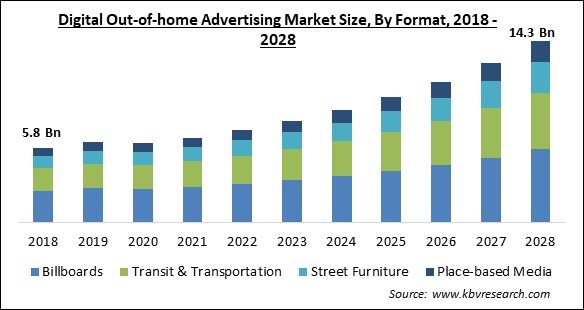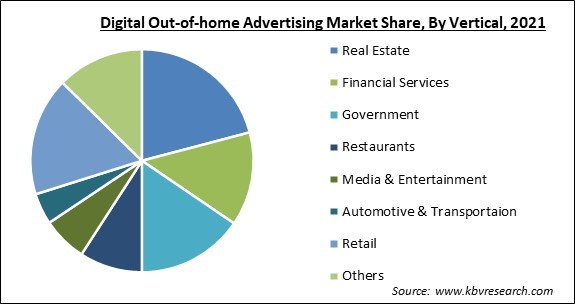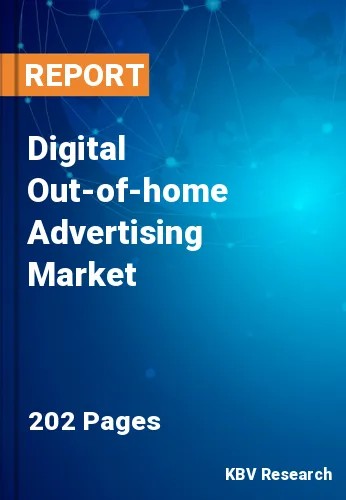The Global Digital Out-of-home Advertising Market size is expected to reach $14.3 billion by 2028, rising at a market growth of 11.9% CAGR during the forecast period.
Digital out-of-home (DOOH) advertising is a type of outdoor advertising that combines both digital and traditional out-of-home components. These digital adverts are displayed on publicly accessible real estate in various locales. Since data is displayed on digital screens in real-time, digital out-of-home commercials give unique and original material, which becomes more interactive and creative. This feature improves the visibility of digital displays. As the desire for interactive commercials among consumers grows, so does the adoption of digital out-of-home advertising, propelling the market forward.
Developed countries continue to dominate the industry, with the highest screen penetration, while demand in underdeveloped countries is growing. The rise in urban population and economic development are contributing to the growing demand. Because of the expansion in the urban population, there has been an increase in spending power, and as a result, firms are heavily targeting those locations to increase their penetration. The Asia-Pacific region has the largest middle-class population, and the region's economic expansion is expected to stimulate advertising spending.
Furthermore, the money spent on advertising has been steadily increasing. For example, the United States of America led the list, followed by China and Japan. When it comes to ROI per screen, the United States of America has been ranked first. Advertisers are also developing more imaginative and interactive street furniture, which allows them to engage their audiences while simultaneously collecting data about them.
Brands can utilize DOOH to effectively advertise products even if they are not equally available everywhere with the right technological partner. For example, if a company wants to launch a new frozen pizza line – initially in a few cities, then nationally – it could utilize DOOH to target each market individually. One might need a campaign stating that the pizzas are currently available, while another might need to emphasize that the new range will be available shortly. Technology allows for fast adjustments based on different locales, DMAs, zip codes, or even audiences, ensuring that overall messages are received locally. A planning process that used to take weeks may now be completed in minutes, with success tracked using indicators like attributable sales and foot traffic.

The COVID-19 outbreak has had a severe impact on the digital out-of-home advertising industry. In reaction to the pandemic and the serious health threat posed by the virus, governments around the world instituted quarantines, lockdowns, travel bans and restrictions, and work-from-home directives to try to contain the virus. These measures have had a severe impact on the digital out-of-home advertising industry's workforce and operations, as well as the behaviors of advertising clients and consumers and the operations of raw material suppliers. Various markets have been negatively impacted by the COVID-19 pandemic as a result of the impact on companies' operating profits.
The increased use of commercial displays in the advertising industry is expected to accelerate the growth of the digital-out-of-home market. The advent of relatively low-cost digital displays can be credited for the growth. The industry is expected to benefit from increased usage of virtual reality and augmented reality, cloud-based platforms, and the growing demand for IoT. In addition, combining DOOH with VR and AR allows businesses to increase the engagement and reach of their initiatives. Cloud-based solutions offer benefits such as flexibility, connection, and improved content management, which are fueling industry demand.
On DOOH, user-generated material leaves a long-lasting impression on the consumer. It provides the kind of relatability that consumers look for in popular advertising. A corporation can efficiently show adverts with the goal of increasing recognition, exposure, and engagement. Placing DOOH in areas where passersby have more idle time, such as bus stops, train stations, or travel mediums, can increase the number of people who see the advertisement. Almost every brand employs expert model airbrushing. The consumer would be enticed to interact more if they saw a peer as a brand's advocate. Not only that, but it will be relatable and memorable to them.
Along the highways, there are numerous billboards. Drivers are more focused on the road than on advertisements on the side of the road. Many billboards are only seen for a second or two at most. Thus, the biggest problem with digital out-of-home advertising formats is their fleeting nature. Companies have to pay large sums of money for their advertisement to be looked at for only seconds on average. As a result, the cost of advertising per exposure may be higher than with other approaches. This factor makes it somewhat unfeasible for small and medium-sized enterprises. Billboards cost more per panel than other types of digital out-of-home advertising, such as shopping center 6-sheets or post office screens.

Based on Format, the market is segmented into Billboards, Transit & Transportation, Street Furniture, and Place-based Media. The transit and transportation segment procured a substantial revenue share in the digital-out-of-home advertising market in 2021. The growing usage of LCD screens in taxis, buses, and trains to display several adverts on a single screen is propelling the market forward. Furthermore, consumer preferences for public transportation such as buses and trains for everyday travel are a crucial driving force for market expansion. Furthermore, the increasing use of digital transit and transportation advertising for product branding and awareness is likely to propel market expansion.
Based on Vertical, the market is segmented into Real Estate, Financial Services, Government, Restaurants, Media & Entertainment, Automotive & Transportation, Retail, and Others. The real estate segment acquired the highest revenue share in the digital out-of-home advertising market in 2021. The construction industry's increased spending on outdoor advertising to showcase their properties and generate brand awareness is propelling the market growth. Furthermore, the growing popularity of digital out-of-home advertising for real estate marketing is speeding market growth due to the high conversion rate of the commercials. Additionally, digital outdoor advertising allows real estate brands to be more creative with a contextually relevant and timely message, which is expected to drive segment growth during the forecast period.
| Report Attribute | Details |
|---|---|
| Market size value in 2021 | USD 6.6 Billion |
| Market size forecast in 2028 | USD 14.3 Billion |
| Base Year | 2021 |
| Historical Period | 2018 to 2020 |
| Forecast Period | 2022 to 2028 |
| Revenue Growth Rate | CAGR of 11.9% from 2022 to 2028 |
| Number of Pages | 202 |
| Number of Tables | 318 |
| Report coverage | Market Trends, Revenue Estimation and Forecast, Segmentation Analysis, Regional and Country Breakdown, Companies Strategic Developments, Company Profiling |
| Segments covered | Format, Vertical, Region |
| Country scope | US, Canada, Mexico, Germany, UK, France, Russia, Spain, Italy, China, Japan, India, South Korea, Singapore, Malaysia, Brazil, Argentina, UAE, Saudi Arabia, South Africa, Nigeria |
| Growth Drivers |
|
| Restraints |
|
Based on Regions, the market is segmented into North America, Europe, Asia Pacific, and Latin America, Middle East & Africa. North America acquired the highest revenue share in the digital out-of-home advertising market in 2021. This is due to increased urbanization and increased consumer awareness of the product's branding. The North American region is one of the most economically developed regions, and thus, there is adequate infrastructure for the boom of DOOH in the region. The Times Square area in New York of the US is one of the most premium examples of DOOH done well. In addition, rising investment in digital out-of-home advertising is likely to fuel regional market growth.
Free Valuable Insights: Global Digital Out-of-home Advertising Market size to reach USD 14.3 Billion by 2028
The market research report covers the analysis of key stake holders of the market. Key companies profiled in the report include JCDecaux Group, Ströer SE & Co. KGaA, Clear Channel Outdoor Holdings, Inc., OUTFRONT Media, Inc., oOH!Media Limited, Broadsign International, LLC, Focus Media Information Technology Ltd., and Global Media Group Services Limited.
By Format
By Vertical
By Geography
The digital out-of-home advertising market size is projected to reach USD 14.3 billion by 2028.
Widespread adoption of displays and popularity of the digital medium are driving the market in coming years, however, DOOH is expensive to implement growth of the market.
JCDecaux Group, Ströer SE & Co. KGaA, Clear Channel Outdoor Holdings, Inc., OUTFRONT Media, Inc., oOH!Media Limited, Broadsign International, LLC, Focus Media Information Technology Ltd., and Global Media Group Services Limited.
The Billboards segment acquired maximum revenue share in the Global Digital Out-of-home Advertising Market by Format in 2021, thereby, achieving a market value of $5.8 billion by 2028.
The North America is the fastest growing region in the Global Digital Out-of-home Advertising Market by Region in 2021.
Our team of dedicated experts can provide you with attractive expansion opportunities for your business.

